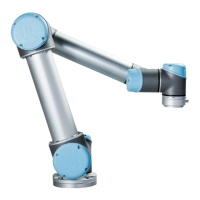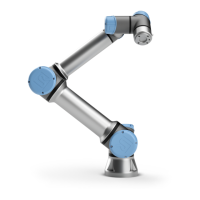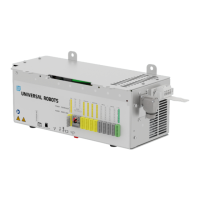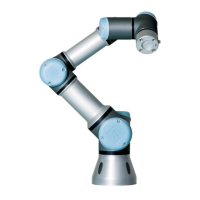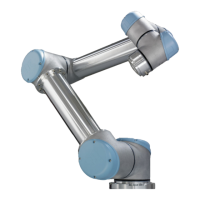14.5 Command: Fixed Waypoint
WP 3 in the direction coming from Waypoint 2 (WP 2). So three waypoints are introduced to
create a path that fulfils the requirements.
Figure 14.2: WP 1: initial position, WP 2: via point, WP 3: pick up position, O: obstacle.
Without configuring other settings, the robot will make a stop at each waypoint, before con-
tinuing the movement. For this task a stop at WP 2 is not optimal since a smooth turn would
require less time and energy while still fulfilling the requirements. It is even acceptable that the
robot does not reach WP 2 exactly, as long as the transition from the first trajectory to the second
happens near this position.
The stop at WP 2 can be avoided by configuring a blend for the waypoint, allowing the robot
to calculate a smooth transition into the next trajectory. The primary parameter for the blend is
a radius. When the robot is within the blend radius of the waypoint it can start blending and
deviate from the original path. This allows for faster and smoother movements, as the robot
does not need to decelerate and re-accelerate.
Blend parameters Apart from the waypoints, multiple parameters will influence the blend
trajectory (see figure 14.3):
• the blend radius (r)
• the initial and final speed of the robot (at positions p1 and p2, respectively)
• the movement time (e.g. if setting a specific time for a trajectory this will influence the
initial/final speed of the robot)
• the trajectory types to blend from and to (MoveL, MoveJ)
If a blend radius is set, the robot arm trajectory blends around the waypoint, allowing the robot
arm not to stop at the point.
Blends cannot overlap, so it is not possible to set a blend radius that overlaps with the blend
radius of a previous or following waypoint as shown in figure 14.4.
Conditional blend trajectories The blend trajectory is affected both by the waypoint where
the blend radius is set and the following one in the program tree. That is, in the program in
figure 14.5 the blend around WP 1 is affected by WP 2. The consequence of this becomes more
apparent when blending around WP 2 in this example. There are two possible ending positions
Version 3.11
Copyright © 2009–2019 by Universal Robots A/S. All rights reserved.
II-73 e-Series
